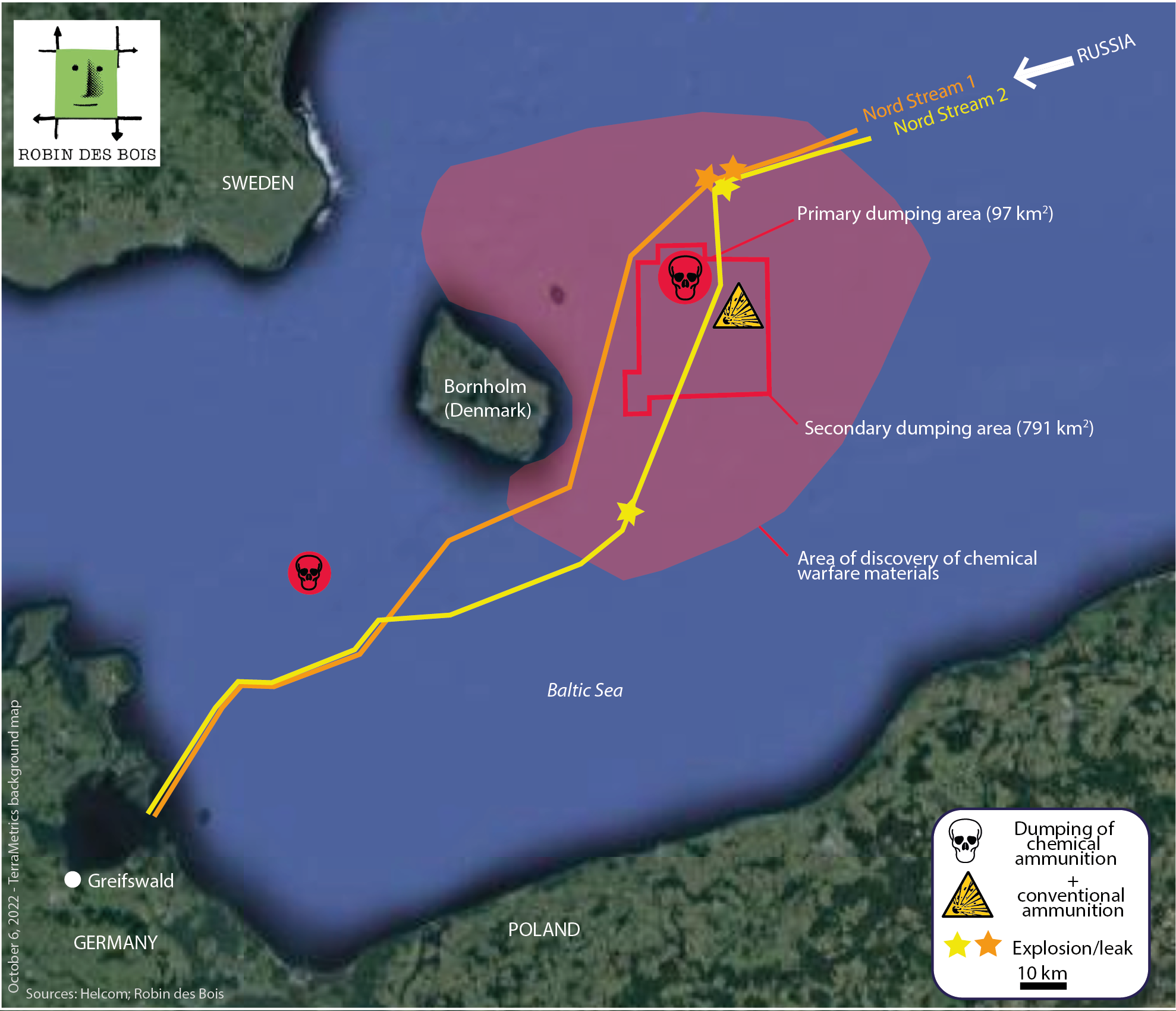Did the explosions followed by gas leaks on 26 September 2022 on the pipelines of the international consortium Nord Stream linking Russia and Germany awake, displace or dislocate chemical munitions dumped near or nearby them? According to Sweden and Denmark, the ruptures of the underwater gas pipelines were caused by explosions equal to several hundred kilograms of TNT, the equivalent of several conventional aerial bombs used during the last World War. Experts from HELCOM (Baltic Marine Environment Protection Commission) estimate that a conventional explosion can produce enough energy and overpressure to disperse chemical warfare agents to unexpected distances.
The area northeast of the Danish island of Bornholm where the explosions took place is the largest underwater dumping area for chemical munitions in the Baltic Sea. The estimated tonnage is between 30,000 and 35,000 tonnes. The known dumping at sea lasted from August 1945 to July 1965. These figures and dates are subject to uncertainty due to the disparity, disappearance and fragmentation of written records and the fragility of oral testimonies.
The Bornholm underwater dump site is a catalogue of all the horrors developed by German chemists and armed forces during the First World War and diversified by the Nazis. The range is complete: vesicants, irritants, lachrymogens, vomitants, sternutatories, lung agents, toxics, neurotoxics and blood agents. The best known are tabun, mustard gas, phosgene and the sinister Zyklon B, which suffocated the deportees in the gas chambers of the extermination camps. At least 300 tonnes of large conventional explosive bombs were also dumped off Bornholm. These unused German munitions or their raw materials and persistent chemical additives were mostly dumped under the supervision of the British and Soviet administrations in occupied Germany and later by the East German authorities.
Bombs, shells, grenades, mines were dumped at sea from barges, hulks or old tubs still available, together with barrels, drums and other containers of chemical munitions precursors.
The primary dumping area was marked by buoys. Boats were loaded to the maximum with the lightest munitions directly accessible. In practice, crews began to dump them before reaching the designated perimeter. The ammunition, often packed in wooden crates, could drift for several miles before sinking. To speed up the evacuation of the docks and warehouses of the departure ports, old tubs and other unidentified floating objects were stuffed with ammunition and sunk in the underwater dump site. Four wrecks were spotted by sonar between 1999 and 2006. Metal carcasses are scattered around and visible on some decks. It is not yet known whether these are conventional or chemical munitions. The Bornholm dump is an open space. At a depth of 70-100m there are no technical devices to prevent the munitions from shifting and decomposing over time due to corrosion, erosion and underwater swell.
Mustard gas appears to be the dominant chemical warfare agent in the area. During the pre-laying works for Nord Stream 1 in the Danish Exclusive Economic Zone, 4 KC 250 mustard gas bombs were discovered between 7 m and 17 m from the projected route. They were inspected prior to laying in autumn-winter 2010. The bombs were in an advanced state of corrosion. Mustard gas lumps were visible. It was estimated that each munition contained 20 kg, i.e. 20% of the initial content of each bomb. The shells were cracked or even dislocated. For each munition, a 15 kg charge of TNT was visible and appeared to be intact. At the request of the Danish authorities, who considered that they did not pose a risk to the gas pipeline, the bombs were left in place. They were inspected again in January 2011, after the pipeline was laid. No further damage was reportedly observed.
Between 1994 and 2012, HELCOM reports that around 4 tonnes of mustard gas lumps were brought to the surface by fishing gear in the Bornholm area. They were mostly dumped at sea in spots designated by the Danish authorities. Between 1968 and 1984, at least 25 Polish fishermen were burnt by mustard gas residues caught in nets in the Bornholm area, and in July 1955, 102 children from a summer camp were burnt on a beach in Darlowo, Poland, opposite Bornholm, after recovering a leaking barrel containing mustard gas from the beach.
Between 1968 and 1984, 196 tonnes of fish contaminated in Danish fishermen’s nets with mustard gas particles were withdrawn from the market and destroyed.
In the long term, residues and breakdown products of the chemicals are likely to accumulate in bottom fish such as sole and omnivorous fish such as cod. Fish in and around the Bornholm underwater dump site suffer from poor health, high rates of skin ulcers and kidney disease compared to similar species caught in outside areas. Fish, crustaceans and all marine organisms living in and around the area are immersed in a carcinogenic, mutagenic and reprotoxic environment.
“The legacy from the past is still resting on the bottom of the sea and is inextricably linked to the fish of today, and it may be that its effects will only be discernible on the consumer of tomorrow.” (1).
Off the coast of France, at least 6 underwater dumping areas contain chemical munitions. One of them, in the Hurd deep off the Cotentin peninsula, was later a dumping ground for nuclear waste.
(1) HELCOM, 2013. Chemical Munitions Dumped in the Baltic Sea. Report of the ad hoc Expert Group to Update and Review the Existing Information on Dumped Chemical Munitions in the Baltic Sea.
